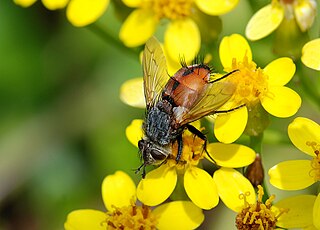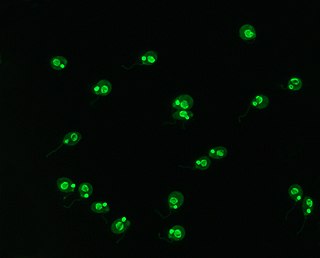
Trypanosomatida is a group of kinetoplastid unicellular organisms distinguished by having only a single flagellum. The name is derived from the Greek trypano (borer) and soma (body) because of the corkscrew-like motion of some trypanosomatid species. All members are exclusively parasitic, found primarily in insects. A few genera have life-cycles involving a secondary host, which may be a vertebrate, invertebrate or plant. These include several species that cause major diseases in humans. Some trypanosomatida are intracellular parasites, with the important exception of Trypanosoma brucei.

The Brachycera are a suborder of the order Diptera. It is a major suborder consisting of around 120 families. Their most distinguishing characteristic is reduced antenna segmentation.

Muscoidea is a superfamily of flies in the subsection Calyptratae. Muscoidea, with approximately 7000 described species, is nearly 5% of the known species level diversity of the Diptera, the true flies. Most muscoid flies are saprophagous, coprophagous or necrophagous as larvae, but some species are parasitic, predatory, or phytophagous. In September 2008, a study was done on the superfamily using both nucleic and mitochondrial DNA and the conclusion suggested that Muscoidea may actually be paraphyletic.

Crithidia is a genus of trypanosomatid Euglenozoa. They are parasites that exclusively parasitise arthropods, mainly insects. They pass from host to host as cysts in infective faeces and typically, the parasites develop in the digestive tracts of insects and interact with the intestinal epithelium using their flagellum. They display very low host-specificity and a single parasite can infect a large range of invertebrate hosts. At different points in its life-cycle, it passes through amastigote, promastigote, and epimastigote phases; the last is particularly characteristic, and similar stages in other trypanosomes are often called crithidial.

The Asilidae are the robber fly family, also called assassin flies. They are powerfully built, bristly flies with a short, stout proboscis enclosing the sharp, sucking hypopharynx. The name "robber flies" reflects their expert predatory habits; they feed mainly or exclusively on other insects and, as a rule, they wait in ambush and catch their prey in flight.

Rhagionidae or snipe flies are a small family of flies. They get their name from the similarity of their often prominent proboscis that looks like the beak of a snipe.

Athericidae is a small family of flies known as water snipe flies or ibis flies. They used to be placed in the family Rhagionidae, but were removed by Stuckenberg in 1973. They are now known to be more closely related to Tabanidae. Species of Athericidae are found worldwide.

Adeleorina is a suborder of parasites in the phylum Apicomplexa.
Austroleptis is a genus of snipe flies, and the sole genus in the family Austroleptidae; until 2010, it was placed in the family Rhagionidae. They are small to moderately sized flies of around 3 to 7.7 mm.
Evocoa is a monotypic genus of flies containing the single species Evocoa chilensis. It is the only genus in the family Evocoidae.

Angomonas deanei is a flagellated trypanosomatid protozoan. As an obligate parasite, it infects the gastrointestinal tract of insects, and is in turn a host to symbiotic bacteria. The bacterial endosymbiont Ca. "Kinetoplastibacterium crithidii" maintains a permanent mutualistic relationship with the protozoan such that it is no longer able to reproduce and survive on its own. The symbiosis, subsequently also discovered in varying degrees in other protists such as Strigomonas culicis, Novymonas esmeraldas, Diplonema japonicumand Diplonema aggregatum are considered as good models for the understanding of the evolution of eukaryotes from prokaryotes, and on the origin of cell organelles.
Phytomonas is a genus of trypanosomatids that infect plant species. Initially described using existing genera in the family Trypanosomatidae, such as Trypanosoma or Leishmania, the nomenclature of Phytomonas was proposed in 1909 in light of their distinct hosts and morphology. When the term was originally coined, no strict criterion was followed, and the term was adopted by the scientific community to describe flagellate protozoa in plants as a matter of convenience. Members of the taxon are globally distributed and have been discovered in members of over 24 plant families. Of these 24, the two main families that are infected by Phytomonas are Euphorbiaceae and Asclepiadiacae. These protists have been found in hosts between 50° latitude North and South, and thus they can be found on all continents save for Antarctica.
Leptomonas moramango is a species of monoxenous trypanosomatid. It is known to parasitise Brachycera flies, and was first found in Madagascar.
Crithidia otongatchiensis is a species of monoxenous trypanosomatid. It is known to parasitise Brachycera flies, and was first found in Ecuador.
Wallaceina raviniae is a species of monoxenous trypanosomatid. It is known to parasitise Brachycera flies, and was first found in Ecuador.
Eremoneura is a clade of flies within the Brachycera that includes the Empidoidea and the Cyclorrhapha and is a sister of the Asilomorpha. They are thought to have evolved around the Mesozoic. The group includes fossils described in the genus Chimeromyia from 125 million year old amber which show both empidoid and cyclorrhaphan characters. The monotypic family Apystomyiidae has also been placed within the Eremoneura as a sister of the Cyclorrhapha.

Blastocrithidia is a genus of parasitic flagellate protist belonging to the family Trypanosomatidae. It is a monoxenous parasite of heteropteran insects, mainly inhabiting their hindgut and glands.
Wallaceina is a genus of parasitic flagellate protist belonging to the family Trypanosomatidae. This generic name is a replacement name for ProteomonasPodlipaev, Frolov et Kolesnikov, 1990 because the latter Proteomonas was already attributed to a cryptomonad. Wallaceina is a taxonomic patronym honoring the protistologist Franklin G. Wallace, a pioneer in the modern taxonomy of trypanosomatids.

Leptomonas is a genus of parasitic flagellate protist belonging to family Trypanosomatidae and subfamily Leishmaniinae sensu Maslov & Lukeš 2012. It is a monoxenous parasite of mainly Hemiptera, Diptera, and Siphonaptera insects.

Archisargidae is an extinct family of brachyceran flies known from the Jurassic and Cretaceous periods. It is part of the extinct superfamily Archisargoidea. Most members of the family are known from the Callovian-Oxfordian Daohugou biota of Inner Mongolia, China, and the equivalently aged Karabastau Formation of Kazakhstan. The family has been found to be paraphyletic with respect to Eremochaetidae in a cladistic analysis.











